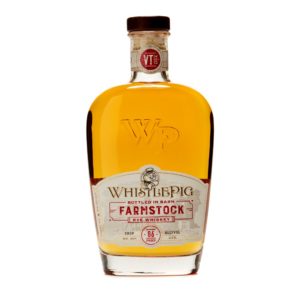By Richard Thomas
Rating: B-
When an independent bottler has built a distillery, it is said they have transitioned from sourcing to making in-house product. Yet it’s not simply building a plant and barreling (or perhaps bottling an unaged version of their) new make that makes that transition a success. Instead, that comes when the company’s in-house product is capable of replacing their sourced whiskey and satisfying their customers.
WhistlePig founder Raj Bhakta committed his whiskey company not just to making that transition, but also to becoming a farm-to-bottle distillery. A crop of rye grown on the same Vermont farm that hosts the distillery was mashed, distilled and barreled shortly after the distillery went operational in October 2015. After approximately 1 1/2 years in the cask, roughly 100 of these barrels were dumped and used to blend Farmstock Crop 001.
This not quite straight, Vermont-made Rye was blended with the two other constituent sources for WhistlePig’s products: MGP’s 95% Rye and Alberta Distillers’ 100% Canadian Rye. The proportions were 20% of the young, Vermont Rye; 31% 12 year old MGP Rye; and 49% 5 year old Alberta Rye. The blend was then bottled at 86 proof (43% ABV).
The WhistlePig Farmstock represents an obvious milestone for the company, but at the same time it’s an interesting embodiment of who they are at this stage of trying to make a successful, full transition from bottler to distiller. Both their stocks of sourced whiskey are represented, as is the earliest release of their in-house product.
The Whiskey
The appearance of this whiskey is on the light side, straddling a line between pale copper and gold with copper highlights. That could be a reflection of the 1/5 of the contents that is less than two years old, but it might also come from the Alberta Distillers content, also rather young. Some Canadian stock is aged in used barrels, and if this was even partly the case here, it would certainly tone the color down. Nearly all of the amber coloring in American whiskey comes from the new white oak it’s aged in, after all.
I found the nose to be quite spicy and somewhat vanilla sweet, with a trace of pine sap dropping down the middle. It’s a touch hot, but the scent has enough body to it to largely offset that. It’s something one notices without becoming annoyed by it.
I found the experience on the palate lacked the body of the nose, however. The liquid had a silky texture, but the fabric there was a bit thin. The spices run to clove, cinnamon, mint and ginger, and there is a citrus and vanilla sweetness. The finish, which adds an earthy, wet clay dimension, fades away quickly, leaving a lasting ball of warmth all by itself.
What needs to be most kept in view about Farmstock isn’t just the presence of a less than two years old Vermont Rye, but also the five year old or so Alberta Distillery stock. Put those two things together and the whiskey has a strong tilt towards immaturity. So it says on paper, and so it comes across the glass. While I think making a product reflecting all three of WhistlePig’s sources was a good one, Farmstock Crop 001 is very much a work in progress, and I wonder if it might not have been better to have waited another year.
The Price
Farmstock Crop 001 is marked at $90. With that price point, this should be of interest only to Rye collectors and diehard WhistlePig fans. Anyone else who is merely curious should seek it out in a bar or an order-by-the-dram arrangement first.
 The Whiskey Reviewer A World of Whiskey, Poured Every Weekday
The Whiskey Reviewer A World of Whiskey, Poured Every Weekday

